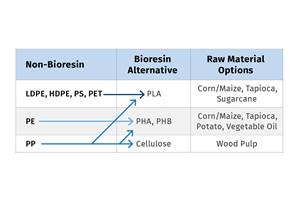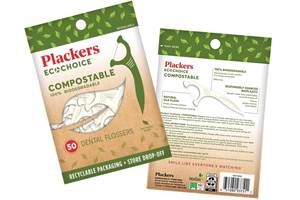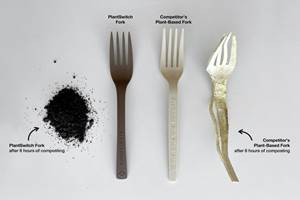Global Analytics Firm Reveals an Immature Innovation Landscape for Bioplastics that is Ripe for Change
Clarivate announced availability of its new bioplastics analytic report on the 50th anniversary of Earth Day.
“From the Plastics Present to a Sustainable Future,” is a report officially unveiled on April 22, the 50th anniversary of Earth Day, that reveals an immature innovation landscape for bioplastics that is ripe for change. The report is available from , of London, U.K. and Philadelphia, Penn. Clarivate is leading global provider of trusted insights and analytics to accelerate the pace of innovation.
Among the key findings of the new report, which unveils the bioplastics innovation landscape, is that bioplastics packaging is at an early developmental stage with no dominant company or entity. According to Clarivate researchers, 40% of all inventions are held by organizational applicants with just a single invention and less than a tenth hold 10 or more inventions.

With growing consumer, governmental and organizational awareness of the need to radically change our approach to plastic usage and disposal, bioplastic has emerged as one of the potential solutions to a more sustainable future. Biodegradable and compostable packaging is a key issue for consumers and regulators. A recent survey, revealed almost three quarters of global consumers want to see single-use plastic banned, and 63% are prepared to change where they shop if it meant using less packaging.
From a patented invention perspective however, according to Clarivate, it is not fast growing. Patent volume increases in bioplastics packaging for food, beverage and cosmetics sectors of between 58% and 70% from 2012 to 2017 simply keep pace with overall patent volumes that similarly grew 70% over the same period, according to the Derwent World Patents Index (DWPI).
Other key points revealed by the new report:
â–ª Only 7% of bioplastics packaging in food, beverage and cosmetics patent applicants hold 10 or more inventions.
â–ª The innovation profile is spread across the supply chain of packaging, from academia through to fast-moving consumer goods (FMCG) firms performing and patenting research.
â–ª Durability of traditional petrochemical-based plastics means innovation in bioplastics packaging is focused on the material’s mechanical properties. The report notes that 488 inventions cite mechanical strength as the motivation for the invention compared to 331 for biodegradable properties.
There is no shortage of exciting bioplastics innovations, including bioplastic containers made from rice starch with a high degree of thermal resistance and mechanical strength and edible bioplastic food wrappers made from corn and shellfish byproducts. However, bioplastics is still a relatively small and nascent market; its global production of 2.11 million tons last year is just a fraction of the more than 359 million tons of plastic produced annually today.
From a patent perspective, bioplastics packaging only constituted 0.02% of all patent output according to DWPI, compared with 5% for pharmaceuticals (not including bio-technology) in 2017. Factors such as bioplastics’ lack of mechanical strength compared to its petrochemical-based counterpart and the economics of production are holding back its growth and development.
From a commercial and trademarks perspective, biodegradable or recyclable plastics are not yet commercially attractive options. They currently comprise just 8% of total plastics trademark applications filed at the United States Patent and Trademark Office (USPTO) and the European Union Intellectual Property Office (EUIPO). Until the economics of production for bioplastics improve, the adoption of bioplastics will continue to be slow.
Said Jeff Roy, president of Clarivate’s IP Group, “Our report reveals plastic is, and will continue to be, a part of our daily life. However, investments in the further development of bioplastics, re-think of traditional plastics design or responsible usage and disposal, will help reduce dependence on traditional plastics. At Clarivate, we operate at the heart of the innovation lifecycle and deliver vital information and insights to organizations that are seeking alternative solutions to the world’s most complex problems, such as plastic waste. With our industry leading solutions, organizations can continue to bring life-changing and environment-saving plastics innovations to market, faster.
Related Content
How to Optimize Your Molds and Hot Runners for Processing Bioresins
Demand for bioresins is growing in molded goods, particularly as a sustainability play to replace fossil-fuel based materials, but these materials are not a drop-in replacement for traditional materials. Molds and hot runners need to be optimized for these materials.
Read MoreHow to Optimize Injection Molding of PHA and PHA/PLA Blends
Here are processing guidelines aimed at both getting the PHA resin into the process without degrading it, and reducing residence time at melt temperatures.
Read MoreCork Compounds for High Strength, Low Weight Performance Composites
Amorim Cork Solutions enable bio-based designs for injection molded products.
Read MoreAdvanced Biobased Materials Company PlantSwitch Gets Support for Commercialization
With participation from venture investment firm NexPoint Capital, PlantSwitch closes it $8M bridge financing round.
Read MoreRead Next
For PLASTICS' CEO Seaholm, NPE to Shine Light on Sustainability Successes
With advocacy, communication and sustainability as three main pillars, Seaholm leads a trade association to NPE that ‘is more active today than we have ever been.’
Read MoreLead the Conversation, Change the Conversation
Coverage of single-use plastics can be both misleading and demoralizing. Here are 10 tips for changing the perception of the plastics industry at your company and in your community.
Read More












